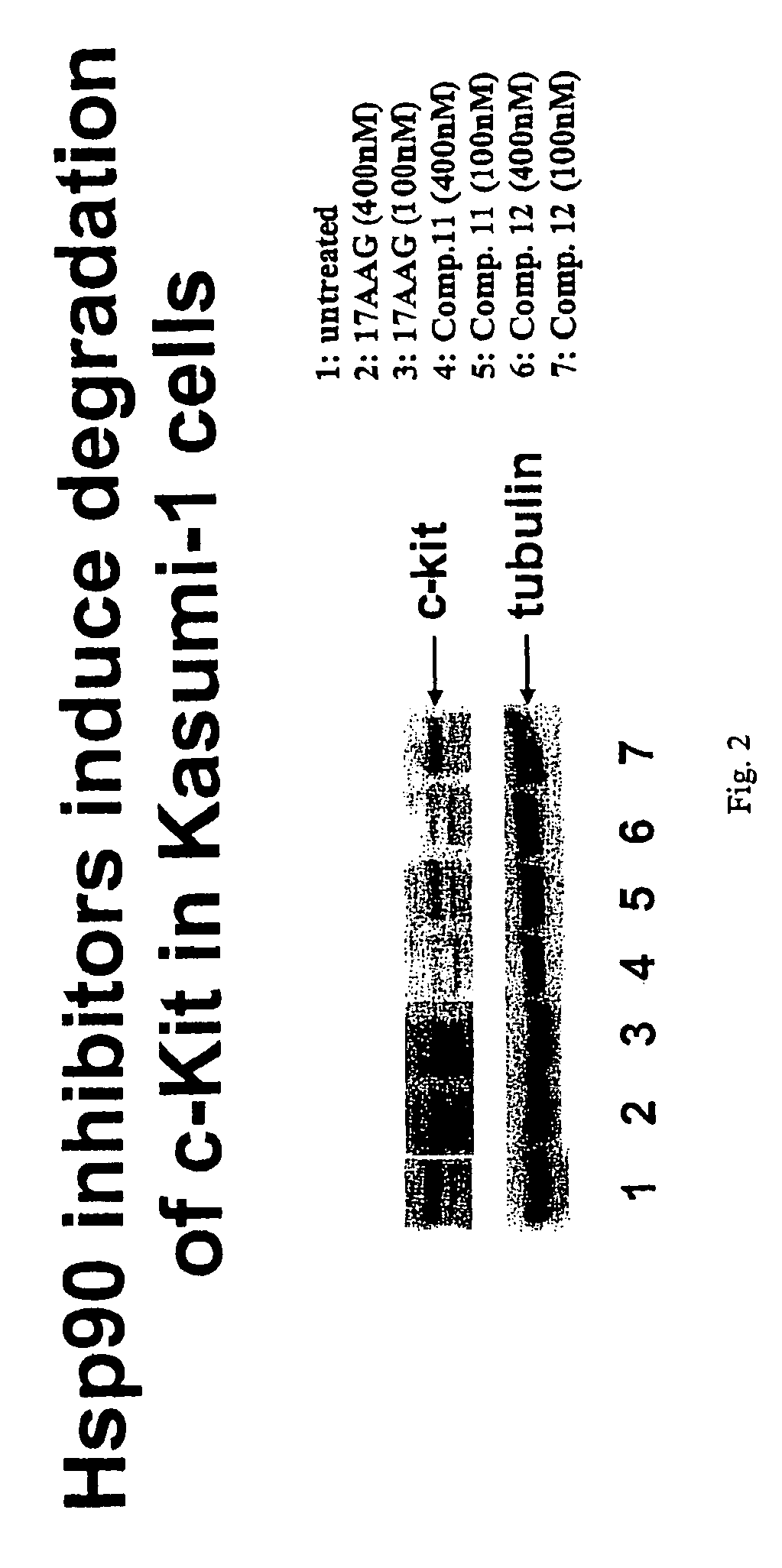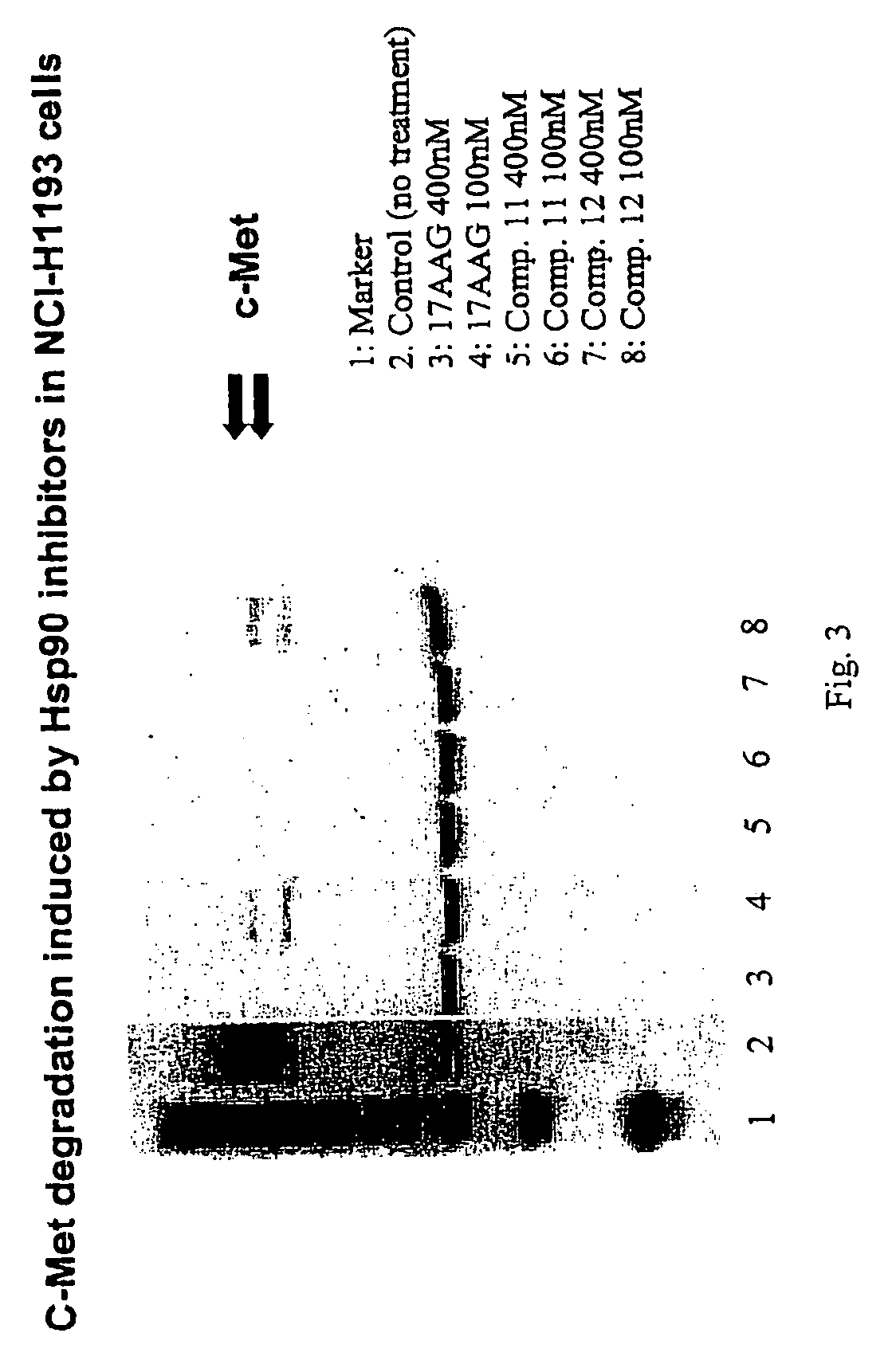Triazole compounds that modulate HSP90 activity
a technology of hsp90 activity and triazole, which is applied in the direction of biocide, cardiovascular disorder, drug composition, etc., can solve the problems of unsatisfactory current chemotherapy, dismal prognosis for the majority of patients diagnosed with cancer, and the inability to fully implement a therapeutic agent that acts on one molecular targ
- Summary
- Abstract
- Description
- Claims
- Application Information
AI Technical Summary
Benefits of technology
Problems solved by technology
Method used
Image
Examples
example 1
4-{5-Hydroxy-4-[4-methoxy-3-(methylpropylamino)phenyl]-4H-[1,2,4]triazol-3-yl}-6-isopropyl-benzene-1,3-diol
[0417]
[0418]To a solution of 2,4-dihydroxy-5-isopropylbenzoic acid methyl ester (1.63 g, 7.75 mmol) in dimethylformamide (DMF) (100 mL) was added potassium carbonate (3.21 g, 23 mmol) then benzyl chloride (1.95 ml, 17 mmol). The suspension was heated to 80° C. for 16 hrs under a nitrogen atmosphere. Ethyl acetate (100 ml) and water (100 ml) were added, and then the ethyl acetate layer was washed with water (3×50 mL), and then dried over magnesium sulfate, filtered and evaporated to dryness to produce the desired compound as brown oil (2.9 g, 97%).
[0419]2,4-Bis-benzyloxy-5-isopropylbenzoic acid methyl ester (3.23 g, 8.27 mmol) and LiOH (1.0 g, 24.8 mmol) were heated in a mixture of tetrahydrofuranyl (THF) / methanol / water (100 mL, 3:1:1) for 16 hrs. Ethyl acetate (100 mL) and water (100 ml) were added, then the ethyl acetate layer was washed with water (3×50 mL), dried over magnes...
example 2
4-Isopropyl-6-{5-mercapto-4-[4-methoxy-3-(methyl-propyl-amino)-phenyl]-4H-[1,2,4]triazol-3-yl}-benzene-1,3-diol
[0425]
[0426]2-methoxy-5-nitroaniline (1) (10.1 g, 60.0 mmol) in 250 mL dichloromethane at 0°-5° C. was treated with triethylamine (10.0 g, 100.0 mmol) and propionyl chloride (6.7 g, 6.3 mL, 72.0 mmol) for 1 hour and 0.5 h at room temperature (RT). Normal aqueous workup and removal of solvent gave a light yellow solid which was washed with hexane / EtOAc (9:1) to yield solid N-(2-Methoxy-5-nitro-phenyl)-propionamide (2) (13.2 g, 98%).
[0427]To a stirred solution of 11.2 g (50.0 mmol) of (2) in 150 mL of anhydrous THF at 0° C. under the nitrogen, was added 3.0 g (75 mmol) of NaH (60% in oil). The suspension was stirred for 0.5 h at 0° C. and 10 mL (150 mmol) of iodomethane was added at 0° C. After the mixture warmed to room temperature and stirred for 3 h, the reaction was quenched by ice brine and extracted with EtOAc (200 mL). The organic phase was washed with brine, dried (Na...
example 3
4-(4-{3-[(2-Dimethylamino-ethyl)-methyl-amino]-4-methoxy-phenyl}-5-mercapto-4H-[1,2,4]triazol-3-yl)-6-isopropyl-benzene-1,3-diol
[0435]
[0436]An oven-dried flask was charged with cesium carbonate (2.28 g, 7 mmol, 1.4 eq), Pd(OAc)2 (79 mg, 0.35 mmol, 0.07 eq), and X-phos (238 mg, 0.5 mmol, 0.1 eq) under nitrogen. 2-bromo-1-methoxy-4-nitrobenzene (1.16 g, 5 mmol, 1 eq), N2,N2,N2-trimethylethane-1,2-diamine (613 mg, 6 mmol, 1.2 eq) and toluene (20 mL, 0.25 M) were added, and the mixture was heated to 100° C. with stirring overnight. The reaction mixture was cooled to room temperature and concentrated. The crude product was then purified by flash chromatography on silica gel to give N1-(2-methoxy-5-nitrophenyl)-N1, N2,N2-trimethylethane-1,2-diamine(2) (340 mg, 1.34 mmol, 27%).
[0437]A solution of 340 mg of N1-(2-methoxy-5-nitrophenyl)-N1,N2,N2-trimethylethane-1,2-diamine (2) in 20 mL of ethanol containing 5% w / w of Pd—C (10%) was subjected to hydrogenation (1 atm, balloon) for 1.5 h. The c...
PUM
| Property | Measurement | Unit |
|---|---|---|
| weight percent | aaaaa | aaaaa |
| weight percent | aaaaa | aaaaa |
| weight percent | aaaaa | aaaaa |
Abstract
Description
Claims
Application Information
 Login to View More
Login to View More - R&D
- Intellectual Property
- Life Sciences
- Materials
- Tech Scout
- Unparalleled Data Quality
- Higher Quality Content
- 60% Fewer Hallucinations
Browse by: Latest US Patents, China's latest patents, Technical Efficacy Thesaurus, Application Domain, Technology Topic, Popular Technical Reports.
© 2025 PatSnap. All rights reserved.Legal|Privacy policy|Modern Slavery Act Transparency Statement|Sitemap|About US| Contact US: help@patsnap.com



